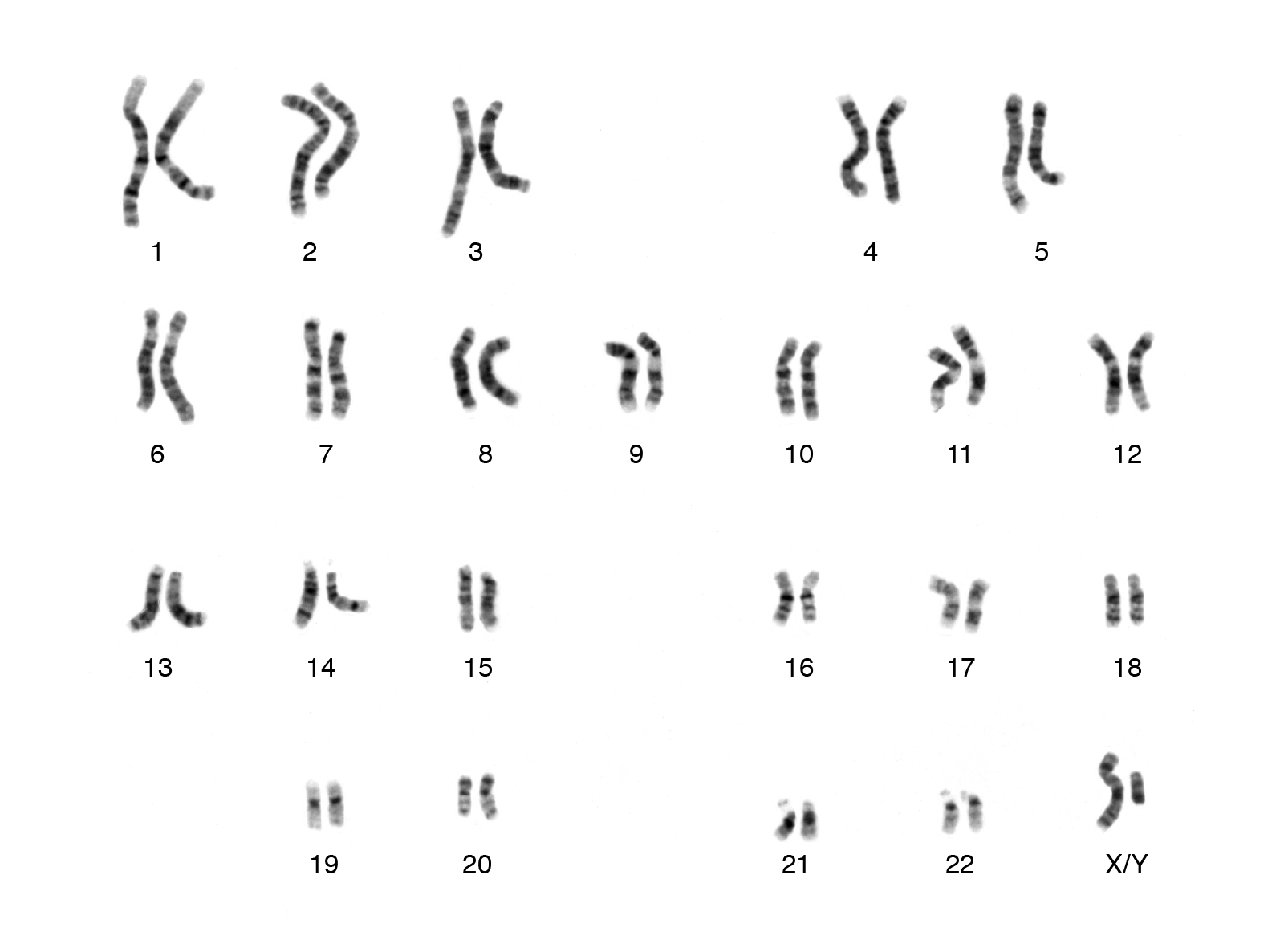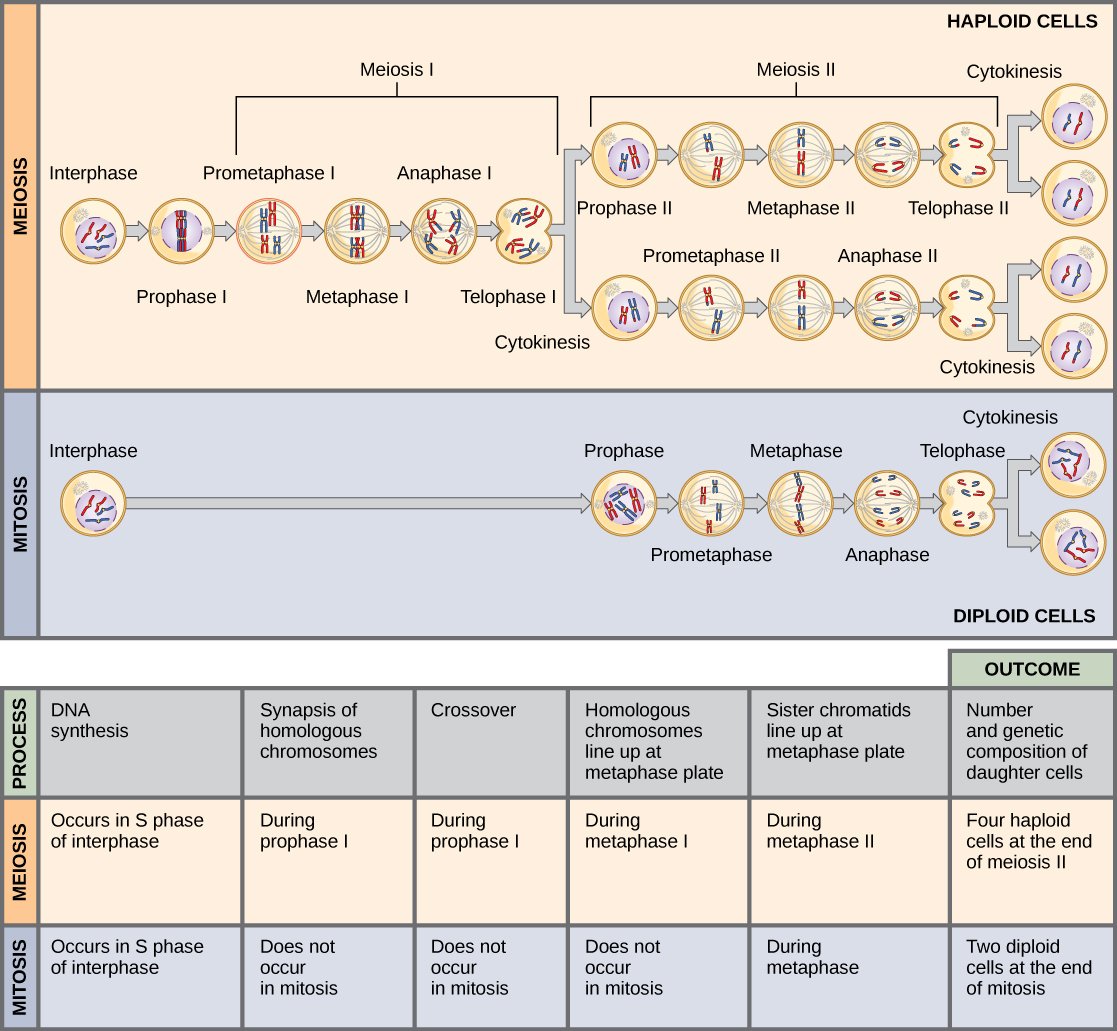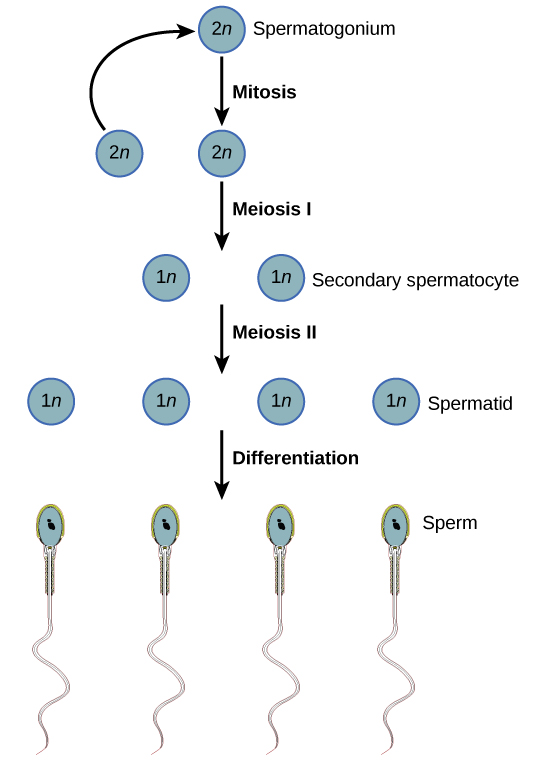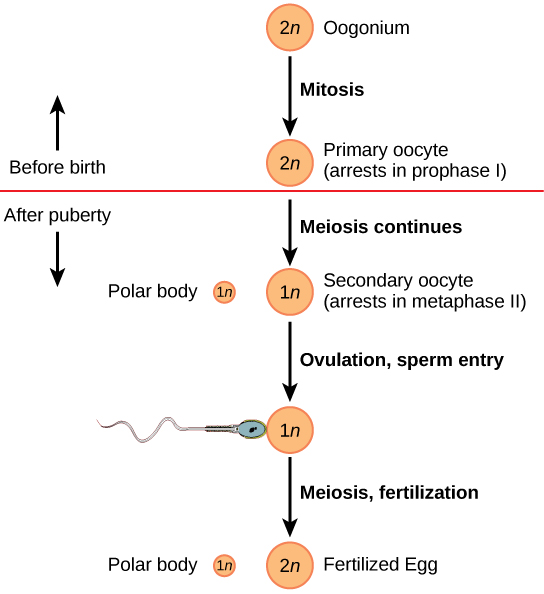2. Meiosis and Gametogenesis
Sexual reproduction requires fertilization, a union of two cells from two individual organisms. If those two cells each contain one set of chromosomes, then the resulting cell contains two sets of chromosomes. The number of sets of chromosomes in a cell is called its ploidy. Haploid cells contain one set of chromosomes. Cells containing two sets of chromosomes are called diploid. If the reproductive cycle is to continue, the diploid cell must somehow reduce its number of chromosome sets before fertilization can occur again, or there will be a continual doubling in the number of chromosome sets in every generation. So, in addition to fertilization, sexual reproduction includes a nuclear division, known as meiosis, that reduces the number of chromosome sets. Meiosis occurs during the process of gametogenesis, which is the production of gametes (oocytes and sperm.)
Figure 1 shows a karyotype of a human male. A karyotype is an image produced by arranging images of each chromosome in a cell into systematic pairs. As you can see, there are 23 total pairs of chromosomes, and 22 of them contain matched pairs of the same size with similar banding patterns, indicating that the cells in each pair contain the same genes. Each of these 22 pairs are called homologous pairs, and the pairs are numbered in order of size, with the two copies of chromosome 1 being the largest. The final pair of chromosomes are not matched in size or banding patterns; these are the sex chromosomes and are called the X chromosome and the Y chromosome. In most human cells, there are 22 matched pairs of chromosomes and 1 pair of sex chromosomes. Almost all males have one X sex chromosome and 1 Y sex chromosome, and almost all females have 2 X sex chromosomes, in each cell. Gametes are unique in that they have half of the chromosomes of other cells: only one sex chromosome and only 22 other chromosomes, not 22 pairs.

Most animals and plants are diploid, containing two sets of chromosomes; in each somatic cell (the nonreproductive cells of a multicellular organism), the nucleus contains two copies of each chromosome that are referred to as homologous chromosomes. Somatic cells are sometimes referred to as “body” cells. Homologous chromosomes are matched pairs containing genes for the same traits in identical locations along their length. Diploid organisms inherit one copy of each homologous chromosome from each parent; all together, they are considered a full set of chromosomes. In animals, haploid cells containing a single copy of each homologous chromosome are found only within gametes. Gametes fuse with another haploid gamete to produce a diploid cell.
The nuclear division that forms haploid cells, which is called meiosis, is related to mitosis. Mitosis is part of a cell reproduction cycle that results in identical daughter nuclei that are also genetically identical to the original parent nucleus. In mitosis, both the parent and the daughter nuclei contain the same number of chromosome sets. Meiosis employs many of the same mechanisms as mitosis. However, the starting nucleus is always diploid and the nuclei that result at the end of a meiotic cell division are haploid. To achieve the reduction in chromosome number, meiosis consists of one round of chromosome duplication and two rounds of nuclear division. Because there are two rounds of division, the stages are designated with a “I” or “II.” Thus, meiosis I is the first round of meiotic division. Meiosis I reduces the number of chromosome sets from two to one. The genetic information is also mixed during this division to create unique recombinant chromosomes. Meiosis II, in which the second round of meiotic division takes place in a way that is similar to mitosis, includes all of the stages of division again. These stages have specific names (Prophase, Metaphase, Anaphase, Telophase), but you are not required to know the specific names of the stages for this course.
*
Interphase
Meiosis is preceded by a stage called interphase. In this stage, the DNA of the chromosomes is replicated, so that each cell contains two copies of each chromatid. This means that in a human cell, both copies of chromosome 1 are copied to produce 4 chromatids, both copies of chromosome 2 are copied to produce 4 chromatids, and so on. The cell also grows, and produces enough of the enzymes and structures required for meiosis during this interphase period.
*
Meiosis I
Early in meiosis I, the chromosomes can be seen clearly microscopically. As the nuclear envelope begins to break down, the proteins associated with homologous chromosomes bring the pair close to each other. The homologous chromosomes now become arranged in the center of the cell, with the ends of each pair of homologous chromosomes facing opposite poles. The orientation of each pair of homologous chromosomes at the center of the cell is random.
This randomness, called independent assortment, is the physical basis for the generation of the second form of genetic variation in offspring. Consider that the homologous chromosomes of a human are originally inherited as two separate sets, one from each parent. One set of 23 chromosomes is present in the egg donated by the mother. The father provides the other set of 23 chromosomes in the sperm that fertilizes the egg. These pairs line up at the midway point between the two poles of the cell, and their arrangement in regard to the two poles is random. Any maternally inherited chromosome may face either pole. Any paternally inherited chromosome may also face either pole. The orientation of each pair is independent of the orientation of the other 22 pairs.
In each cell that undergoes meiosis, the arrangement of the chromosomes is different. There are two possibilities for orientation (for each pair); thus, the possible number of alignments equals 2n where n is the number of chromosomes per set. Humans have 23 chromosome pairs, which results in over eight million (223) possibilities. Other mechanisms not discussed in this class can increase the variation in each cell produced as well. Given both independent assortment and these other mechanisms, it is highly unlikely that any two haploid cells resulting from meiosis will have the same genetic composition.
Next, protein fibers in the cell pull the linked chromosomes apart. The fibers pull the chromosome to the opposite poles of the cell. At each pole, there is just one member of each pair of the homologous chromosomes, so only one full set of the chromosomes is present. This is why the cells are considered haploid—there is only one chromosome set, even though there are duplicate copies of the set because each homolog still consists of two “sister: chromatids that are still attached to each other. Cytokinesis, where the cell membrane pinches off in the center of the cell to separate it into two, now occurs, splitting each cell into two cells containing one full set of chromosomes.
Concept in Action
*
Meiosis II
In meiosis II, the connected sister chromatids remaining in the haploid cells from meiosis I will be split to form four haploid cells. The two cells produced in meiosis I go through the events of meiosis II in synchrony. Overall, meiosis II resembles the mitotic division of a haploid cell.
First, the nuclear envelope breaks down and the chromosomes are clearly visible under a microscope. The sister chromatids then line up at the center of the cell. Protein fibers pull one of each pair of sisters toward the poles of the cell.The chromosomes arrive at opposite poles.. Nuclear envelopes form around the chromosomes. Cytokinesis separates the two cells into four genetically unique haploid cells. At this point, the nuclei in the newly produced cells are both haploid and have only one copy of the single set of chromosomes. The cells produced are genetically unique because of the random assortment of paternal and maternal homologs and because of other sources of variation not discussed here.
*
Comparing Meiosis and Mitosis
Mitosis and meiosis, which are both forms of division of the nucleus in eukaryotic cells, share some similarities, but also exhibit distinct differences that lead to their very different outcomes. Mitosis is a single nuclear division that results in two nuclei, usually partitioned into two new cells. The nuclei resulting from a mitotic division are genetically identical to the original. They have the same number of sets of chromosomes: one in the case of haploid cells, and two in the case of diploid cells. On the other hand, meiosis is two nuclear divisions that result in four nuclei, usually partitioned into four new cells. The nuclei resulting from meiosis are never genetically identical, and they contain one chromosome set only—this is half the number of the original cell, which was diploid (Figure 2).
The differences in the outcomes of meiosis and mitosis occur because of differences in the behavior of the chromosomes during each process. Most of these differences in the processes occur in meiosis I, which is a very different nuclear division than mitosis. In meiosis I, the homologous chromosome pairs become associated with each other, are bound together, experience chiasmata and crossover between sister chromatids, and line up along the metaphase plate in tetrads with spindle fibers from opposite spindle poles attached to each kinetochore of a homolog in a tetrad. All of these events occur only in meiosis I, never in mitosis.
Homologous chromosomes move to opposite poles during meiosis I so the number of sets of chromosomes in each nucleus-to-be is reduced from two to one. For this reason, meiosis I is referred to as a reduction division. There is no such reduction in ploidy level in mitosis.
Meiosis II is much more analogous to a mitotic division. In this case, duplicated chromosomes (only one set of them) line up at the center of the cell with divided kinetochores attached to spindle fibers from opposite poles. As in mitotis, one sister chromatid is pulled to one pole and the other sister chromatid is pulled to the other pole during meiosis II. Meiosis II is not a reduction division because, although there are fewer copies of the genome in the resulting cells, there is still one set of chromosomes, as there was at the end of meiosis I.
Cells produced by mitosis will function in different parts of the body as a part of growth or replacing dead or damaged cells, but cells produced by meiosis will only participate in sexual reproduction.

Concept in Action
*
Gametogenesis (Spermatogenesis and Oogenesis)
Gametogenesis, the production of sperm and eggs, includes the process of meiosis to produce haploid cells, and growth and maturation of these cells into oocytes and sperm. The production of sperm is called spermatogenesis and the production of eggs is called oogenesis.
Spermatogenesis

Spermatogenesis, illustrated in Figure 3, occurs in the wall of the seminiferous tubules, with stem cells at the periphery of the tube and the spermatozoa at the lumen of the tube. Immediately under the capsule of the tubule are diploid, undifferentiated cells. These stem cells, called spermatogonia (singular: spermatagonium), go through mitosis with one offspring going on to differentiate into a sperm cell and the other giving rise to the next generation of sperm.
Meiosis starts with a cell called a primary spermatocyte. At the end of the first meiotic division, a haploid cell is produced called a secondary spermatocyte. This cell is haploid and must go through another meiotic cell division. The cell produced at the end of meiosis is called a spermatid and when it reaches the lumen of the tubule and grows a flagellum, it is called a sperm cell. Four sperm result from each primary spermatocyte that goes through meiosis.
Stem cells are deposited during gestation and are present at birth through the beginning of adolescence, but in an inactive state. During adolescence, gonadotropic hormones from the anterior pituitary cause the activation of these cells and the production of viable sperm. This continues into old age.
Link to Learning
Oogenesis
Oogenesis, illustrated in Figure 4, occurs in the outermost layers of the ovaries. As with sperm production, oogenesis starts with a germ cell, called an oogonium (plural: oogonia), but this cell undergoes mitosis to increase in number, eventually resulting in up to about one to two million cells in the embryo.

The cell starting meiosis is called a primary oocyte, as shown in Figure 4. This cell will start the meiosis I and be arrested in its progress very early on, in a stage called the first prophase stage. At the time of birth, all future oocytes are in the prophase stage; no additional oocytes or precursors are produced after birth. At adolescence, anterior pituitary hormones cause the development of a number of follicles in an ovary. This results in the primary oocyte finishing meiosis I. The cell divides unequally, with most of the cellular material and organelles going to one cell, called a secondary oocyte, and only one set of chromosomes and a small amount of cytoplasm going to the other cell. This second cell is called a polar body and usually dies. A secondary meiotic arrest occurs, about halfway through the meiosis II in a stage called the metaphase II stage. At ovulation, this secondary oocyte will be released and travel toward the uterus through the oviduct. If the secondary oocyte is fertilized, the cell continues through meiosis II, producing a second polar body and a fertilized egg containing all 46 chromosomes of a human being, half of them coming from the sperm. If the oocyte is not fertilized, however, it does not complete meiosis II.
Oocyte production begins before birth, is arrested during meiosis until puberty, and then individual cells continue through at each menstrual cycle. One oocyte is produced from each meiotic process, with the extra chromosomes and chromatids going into polar bodies that degenerate and are reabsorbed by the body.
Section Summary
Sexual reproduction in humans requires that diploid individual cells produce haploid cells that can fuse during fertilization to form diploid offspring. The process that results in haploid cells is called meiosis. Meiosis is a series of events that arrange and separate chromosomes into daughter cells. During the interphase of meiosis, each chromosome is duplicated. In meiosis, there are two rounds of nuclear division resulting in four nuclei and usually four haploid daughter cells, each with half the number of chromosomes as the parent cell. During meiosis, variation in the daughter nuclei is introduced because of random alignment in meiosis I. The cells that are produced by meiosis are genetically unique.
Meiosis and mitosis share similarities, but have distinct outcomes. Mitotic divisions are single nuclear divisions that produce daughter nuclei that are genetically identical and have the same number of chromosome sets as the original cell. Meiotic divisions are two nuclear divisions that produce four daughter nuclei that are genetically different and have one chromosome set rather than the two sets the parent cell had. The main differences between the processes occur in the first division of meiosis. The homologous chromosomes separate into different nuclei during meiosis I causing a reduction of ploidy level. The second division of meiosis is much more similar to a mitotic division.
Important similarities exist between spermatogenesis and oogenesis: during both processes a diploid cell is duplicated a number of times in mitosis to produce precursors that undergo two rounds of meiosis to produce haploid sperm and eggs. Important differences exist in the timing of these divisions and in the symmetry of divisions. In males, each spermatagonium produces four mature sperm, but in oogenesis each oogonium can produce only one fertilized egg.
*
Glossary
- fertilization
- the union of two haploid cells typically from two individual organisms
- karyotype
- systematic arrangement of images of chromosomes into homologous pairs
- meiosis I
- the first round of meiotic cell division; referred to as reduction division because the resulting cells are haploid
- meiosis II
- the second round of meiotic cell division following meiosis I; sister chromatids are separated from each other, and the result is four unique haploid cells
- oogenesis
- the process of producing haploid eggs
- reduction division
- a nuclear division that produces daughter nuclei each having one-half as many chromosome sets as the parental nucleus; meiosis I is a reduction division
- somatic cell
- all the cells of a multicellular organism except the gamete-forming cells
- spermatogenesis
- the process of producing haploid sperm
-
CC LICENSED CONTENT, SHARED PREVIOUSLY
OpenStax, Concepts of Biology, Section 7.2 Meiosis
Provided by: Rice University
Access for free at https://openstax.org/details/books/concepts-biology
OpenStax, Biology, Section 43.3 Human Reproductive Anatomy And Gametogenesis
Provided by: Rice University
Access for free at https://openstax.org/details/books/biology-2e
License: CC-BY 4.0
Adapted By: Sarah Malmquist

